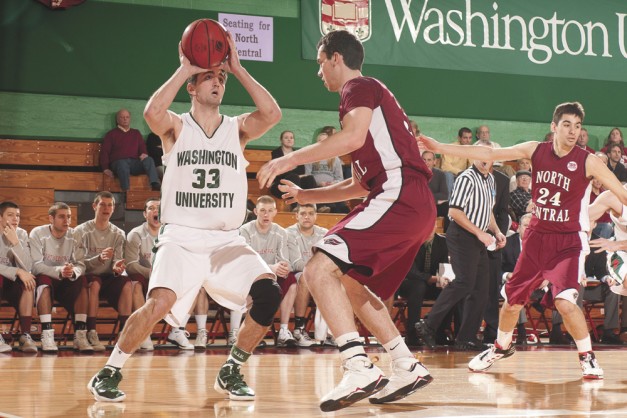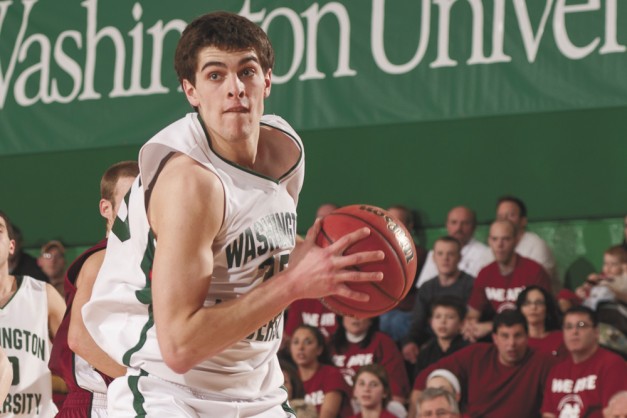Men's Basketball
Men’s basketball forwards play big role in team’s dominance
Junior Chris Klimek pulls up for a jumper against North Central College in last year’s NCAA second round. Klimek is averaging 17.0 points per game this year.
In the midst of applying to medical school, Burnett has averaged 12.4 points and 7.6 rebounds per game to rank second on the team in both categories. After sitting out his entire freshman season because of injury, Klimek has built on a strong sophomore campaign with a team-leading 17.0 points per game on scorching 73.1 percent shooting. Palucki controls the boards for the Bears, pulling down 8.4 rebounds per game while chipping in 11.4 points.
Student Life chatted with the frontcourt trio about the team’s hot start to the 2012-13 season.
Student Life: You three combined are averaging about 40 points and 20 rebounds per game, which is about half the team’s total output in those areas. The team has also outscored opponents by an average of 20 points per game in the paint. What do you think are the factors behind the success of the frontcourt so far?
Chris Klimek: Well, I think a lot of it comes from the actual offense. When we do know that we have a size advantage, we have plays to incorporate mostly just us in the post. And we found that in the first couple of games, we did have a pretty significant size advantage, and we ran the plays that did give us the touches. If we do play a bigger team, we have plays where the backcourt shoots the ball more, but with our size, we’re pretty freakin’ huge. It’s unbelievable—I’ll go up for a rebound, and both of these guys will be here snatching it up already.
Rob Burnett: The other thing is that it’s a team effort, and even though we have those numbers, it’s everybody boxing out his own individual guy and contributing to the offense as hard as they can; it’s really giving us the numbers that we have.
Matt Palucki: I would say that all the guys, including the guards, too—we pass the ball really well and we find the opening, which allows for the big guys not to take really tough shots, and we’re getting really easy shots in the lane, which leads to the scoring.
SL: Behind the dominance inside, the team has started 5-0. How do you maintain this pace?
Senior Rob Burnett goes up for a jump shot over a North Central College defender in last year’s NCAA second round. Burnett is averaging 12.4 points and 7.6 rebounds per game in his first year as a starter.
CK: Also, just going into the game [with the mindset that] you prepare for that game—your main goal is to win that specific game that night. I think we’ve done a really good job because…say this is a couple years ago, we’d be, like, “Oh, we have Illinois Wesleyan [University] in a couple weeks, possibly in the Lopata Classic,” and we’d worry about them. This year we’ve done a really good job focusing on this scouting report, this team and getting the win.
SL: You guys are all at least 6-foot-5, which makes for a pretty big frontcourt in Division III. How have you used this size to your advantage so far this season?
RB: What size brings to the table is defense and rebounding, and that’s where we can count on a consistent performance in each game, and it carries us to a win in each game because with size, you’ve got a defensive presence where you feel like other teams don’t want to drive on you. They don’t want to attack inside a big defensive frontcourt, and rebounding—our rebounding margin is like plus-20—and that’s just helping us get more possessions and more shots at the basket than the other team.
MP: I think the main thing, with us being that tall, we need to dominate the boards every game. If we don’t dominate the boards, then we probably don’t have a very good chance to win, so both the defense and offensive boards, if we can dominate those, we’ll have a good chance to win every game.
SL: Matt, you’ve made the transition from playing mostly power forward last year to this year working on the small forward game. How has that adjustment been for you so far, and what did you work on over the summer to make it?
Sophomore Matt Palucki goes up for a fast break layup in last year’s NCAA second round contest against North Central College. Palucki is averaging 11.4 points and 8.4 rebounds per game after switching to small forward in the offseason.
SL: Rob, you’re a new starter this year. How has the transition been from the bench to a starting role?
RB: For the last two years, I’ve been behind [graduated center] Alex Toth, and coming in as a starter this year has kind of been an easy transition because I’ve had a lot of time in the games, and I feel comfortable with the players I’m starting with.
SL: Chris, you’re the team’s leading scorer at 17.0 points per game. Can you talk a little bit about taking the mantle of offensive first option this year?
CK: I wouldn’t necessarily say “offensive first option” just because our offensive scheme allows for those shots…My teammates have done a really good job of getting the ball exactly where it needs to be so I can make the easy layup or get to the line for free throws…I really think the difficulty that other teams have guarding us is that we do have so many weapons. So if Rob and I have an off night, [junior guard] Tim Cooney is stepping up, Matt Palucki is stepping up, [junior guard] Alan Aboona is stepping up. Last game, [junior guard] Kevin Bischoff stepped up and won that game for us.
SL: This weekend, you guys play in the 29th annual Lopata Classic, where you have an opportunity to face Illinois Wesleyan, the No. 7 team in the country. What are you guys looking to prove in this weekend’s games specifically?
RB: Well, over the last two years, our program has really built itself up getting big wins. When we took down No. 1 Augustana [College] in the Lopata Classic last year, it was an unbelievable experience for our team as far as our growth and maturity. And we think we have the same parts, if not an even better chance to do it again this year, and we’re really looking to just use this weekend to grow and get better as a team.
CK: I feel Illinois Wesleyan isn’t the end-all, be-all. It’s a good measuring stick. We know we’ve played some pretty quality teams so far, but we don’t know if they’re the top-25-level teams, so it’ll be nice to see how we measure up against the No. 7 team and see how far along we came and how much further we need to go.
MP: We’re looking to prove that we’re a top-10 team. We just recently broke [into] the top 10. I think playing both Wilmington [College] and Illinois Wesleyan will be a great test to see…how good we actually are.



